William Doyle
-
- Regulatory Profile: William P. Doyle, Commissioner of the Federal Maritime Commission Maritime Logistics Professional, Q1 2014 #58
If the Federal Maritime Commission remains somewhat of an enigma to domestic maritime stakeholders, perhaps that’s because its scope of oversight reaches many sectors of maritime business; some more obscure than others. In February, we caught up with FMC commissioner William P. Doyle, who provided the perfect primer on this important agency. What does it take to become a Federal Maritime Commissioner? As it turns out; plenty:
Doyle was sworn in on January 10, 2013 as Commissioner of the Federal Maritime Commission. All told, Doyle has over 20 years of experience in the transportation industry, including both the maritime and energy sectors and has held several senior executive positions. These include an executive role as the Director of Permits, Scheduling, and Compliance with the Office of the Federal Coordinator for Alaska Natural Gas Transportation Projects. There, he managed and directed the permitting and regulatory coordination of 24 federal agencies, numerous State of Alaska agencies, and both federal and provincial agencies of Canada. A 1992 graduate of the Massachusetts Maritime Academy, Doyle’s career path has taken him to sea as a marine engineer, into the shipyard and eventually, to law school. Doyle served over a decade as a merchant officer aboard numerous classes of vessels and he also spent as MEBA Deputy General Counsel, Director of Government & Legislative Affairs and later became Chief-of-Staff.
FMC Defined
According to Doyle, The FMC may not be widely known and/or understood, but it has a longstanding, important, and multifaceted role. He explains, “The Mission of the FMC is to foster a fair, efficient and reliable international ocean transportation system and to protect the public from unfair and deceptive practices. We strive to meet that goal in several ways,” adding, “I really do enjoy being a Commissioner.”
The FMC receives complaints and offers alternative dispute resolution services (ombuds assistance, mediation and arbitration) in attempt to reach a timely settlement and has administrative law judges (ALJs) who issue binding decisions. Doyle says, “We act as an appeals court per se, and rule on decisions made by the ALJs and consider appeals of ALJ decisions. Cases we decide include the shipment of goods by small business and disputes between and among marine terminal operators (MTOs) and common carriers.”
High Energy
Of interest to energy stakeholders, Doyle, in a previous life, has served as Representative on the U.S. delegation for the United States on the bilateral trade delegation for the U.S. – Canada Energy Consultative Mechanism meetings, bilateral energy trade issue talks intended to strengthen the largest bilateral energy relationship in the world. Beyond that, he represented the U.S. in the annual coordination meeting between the U.S. Pipeline and Hazardous Materials Safety Administration and Canada’s National Energy Board. And, he was selected by the U.S. Department of State to participate in an international shale gas workshop to assess international resources, supply options, and market conditions.
Cruise Bonding & Consumer Protection
The Commission’s Bureau of Certification and Licensing (BCL) is responsible for Passenger Vessel Certification. The BCL includes the Office of Passenger Vessels and Information Processing (OPVIP). OPVIP receives and reviews applications from passenger vessel operators (PVOs) for Certificates (Performance) and Certificates (Casualty) and the associated coverage evidencing acceptable forms of financial responsibility. In this case, the Certificate (Performance) indicates that the PVO has filed acceptable evidence of financial responsibility with the Commission. The coverage is used to reimburse passengers when the PVO fails to perform cruises as contracted and has taken no further actions to refund passengers. The Certificate (Casualty) indicates that the PVO has filed acceptable evidence of financial responsibility with the Commission which can be used to pay claims for death or injury to passengers and other persons on voyages covered by the program.
Cruise lines typically require that prospective passengers provide a deposit in advance of a voyage. In the cruise industry the collection of deposits from consumers is known as unearned passenger revenue. Doyle says, “That’s fine, but occasionally something goes awry: a scheduled cruise fails to sail or is not completed, or there is a casualty. Since the year 2000, 15 passenger vessel operators have gone out of business, one of which had collected $51 million in deposits from would-be passengers. So, to protect consumers, the FMC requires cruise lines to have proper financial backing to refund passenger deposits should a cruise line fail to perform on its contract.”
Roots: Marad & FMC
FMC’s history dates all the way back to its relationship with the U.S. Maritime Administration and subsequent separation. During World War I, Congress feared that collective liner pricing organizations (conferences) would use their market power to unreasonably raise rates or reduce services. Hence, the Federal Shipping Act of 1916 was enacted, thereby creating the United States Shipping Board. In those days, says Doyle, the United States Shipping Board and its immediate successor organization, the United States Maritime Commission, combined the roles of regulatory policeman and promoter.
Later, the Merchant Marine Act charged the United States Shipping Board with monitoring and responding to foreign regulations that create conditions unfavorable to shipping in the foreign trade. In 1933, an executive order transferred the United States Shipping Board’s functions to the U.S. Shipping Board Bureau in the Department of Commerce. In 1936, Congress separated the Board from the Commerce Department, creating the United States Maritime Commission. Joseph P. Kennedy served as its first Chairman.
In 1950, the regulatory programs of the United States Maritime Commission were transferred to the Federal Maritime Board at the Department of Commerce, where they resided until the FMC’s creation in 1961. And, in 1961, the performance of regulatory and promotional functions were separated, resulting in the formation of the U.S. Maritime Administration and the Federal Maritime Commission.
Doyle explains, “Not just the name changed, the laws we administer are periodically modernized to adjust to the dynamic maritime industry. The Shipping Act of 1984 was enacted, which among other things introduced the concept of contract carriage with service contracts filed with the FMC. In 1998, after a study of the 1984 Act and review by an advisory commission, a second round of deregulatory liner legislation was enacted – The Ocean Shipping Reform Act of 1998.”
Today, FMC works with the U.S. Department of Transportation and MARAD on the recently implemented Value Added Tax (VAT) by the People’s Republic of China (China). The issue pertaining to the VAT is whether there is any unfairness in application of the tax. For the past several years, the United States and China have held annual U.S. Bilateral Maritime Consultations.
FMC also works with MARAD on the Maritime Security Program (MSP). Doyle explains, “I’m mindful that one purpose of the Shipping Act is to encourage development of an economically sound and efficient liner fleet of vessels that is capable of meeting national security needs. I have made it clear that I am a strong supporter of the U.S.-flag. And, in my role as a Commissioner, I make it my business to look after the U.S.-flag international fleet. There’s a lot going on in the international flag fleet—proposed carrier alliances, proposed carrier expansions to vessel sharing agreements and the like—and as we know, major carriers in the MSP are parented by international owners. Some of the carriers who have proposals before the Commission have ships enrolled in the MSP.”
As over-capacity in the international container trades persists, with fuel costs for ships remaining stubbornly high, spot container freight rates have remained low for a long period of time. Noting this, Doyle told MarPro, “Carriers are doing everything they can to cut costs and streamline operations that may include new and/or expanded alliances. That said; I don’t want to see our U.S.-flag international fleet harmed during this period of transformation. The United States relies on these companies and their ships during times of conflict. That’s why it has been so important for me to keep current on latest developments coming out of MARAD.”
The Harbor Maintenance Tax and Trust Fund
In 2012, the FMC undertook a study of U.S. inland containerized cargo moving through ports in Canada and Mexico. At the time, some lawmakers were concerned about whether the Harbor Maintenance Tax (HMT) played a role in cargo being shifted from U.S. ports to ports in Canada and Mexico. While FMC does not have regulatory authority over the HMT, the Commission analyzed potential impacts HMT may have with respect to cargo diversion. FMC ultimately determined that the current HMT structure is just one of several issues shippers weigh in their cargo routing decisions. Doyle adds, “The FMC has communicated its findings to Congress. We will be guided by any legislation enacted by Congress and we continue to offer our comments and expertise when requested.”
FMC and OTI’s
The FMC regulates ocean transportation intermediaries (also known as OTIs). The term OTI encompasses Ocean Freight Forwarders (OFFs) and Non-vessel Operating Common Carriers (NVOCCs). For many, these “brokers” or middlemen are the only parties with which they will interact in moving goods. Doyle insists that businesses should only use FMC- licensed ocean transportation intermediaries for their movements. He adds, “Concurrent with licensed participants, there are unlicensed, rogue operators out there. These are the bad actors, if you will.” To help the shipping public, Doyle explains, the FMC posts a list of licensed OTIs on its website where one can search by a company’s name or by a location. There are approximately 4,000 licensed OTIs in the United States. U.S.-based companies or sole proprietors operating as either an OFFs or NVOCCs are required to obtain a license from the FMC. Non-U.S. based NVOCCs are not required to, but they may obtain an FMC-issued license. Doyle adds, “The general difference between OFFs and NVOCCs is that an NVOCC acts as the carrier of the cargo being sent.” The Commission is currently reviewing comments as a result of an advanced notice of proposed rulemaking that could affect OTIs, with the ultimate goal of balancing the needs of consumers with those of the industry.
The Commission’s Area Representatives also participate in investigations of potential violations of the Shipping Act and Commission regulations, working with Bureau of Enforcement (BOE), which is the prosecutorial arm of the Commission. BOE attorneys also negotiate settlements and informal compromises of civil penalties, and may act as investigative offices in formal fact-finding investigations. During the first 10 months of 2013, the FMC completed seven compromise agreements from companies that violated the Shipping Act. The recovery totaled of $617,500 in civil penalties. The alleged violations include providing service that was not in accordance with the rates or charges contained in their tariffs, failure to be properly bonded and falsifying cargo declarations related to service contracts.
FMC: Fairness, Transparency & Justice for All
Vessel sharing agreements and proposed carrier alliances are another area of FMC oversight. Under the Shipping Act, carriers are allowed limited antitrust immunity. The FMC is currently considering what the trade-press has dubbed “mega alliances” involving the world’s top International container lines interested in expanding or forming vessel sharing arrangements. In reviewing agreements filed with the FMC, the Commission’s regulatory role is to determine whether the agreement is likely, by a reduction in competition, to produce an unreasonable decrease in transportation service or an unreasonable increase in transportation cost.
In December of 2013, the Commission reached compromise agreements with two international-flag car carriers with penalties totaling $2.3 Million. The carriers were found to have acted in concert with other ocean common carriers with respect to the shipment of automobiles and other motorized vehicles by car carrier vessels, where such agreement(s) had not been filed with the Commission or become effective under the Shipping Act. Commission staff alleged that these practices persisted over a period of several years and involved numerous U.S. international trade lanes.
William Doyle says, “It is important that common carriers follow the law. The FMC takes seriously carriers’ obligation to file with the Commission any agreement with other carriers affecting working relationships in the U.S. trades, both for import and export traffic. The shipping public has a right to know the subject matter and scope of any such agreement, and the Commission is charged by Congress to oversee the parties’ operations and conduct under such agreements.”
(As published in the 1Q 2014 edition of Maritime Professional - www.maritimeprofessional.com)
-
- Managing the New Panamax Containerships Maritime Logistics Professional, Sep/Oct 2017 #36
percent of respondents listed “optimizing operations to improve productivity” as their biggest challenge. MLPro also spoke with FMC Commissioner William Doyle regarding the challenges of mega-ships, and the reverberations down the supply chain. He said, “Ocean carriers are building larger ships and those
-
- Managing the New Panamax Containerships Maritime Reporter, Nov 2017 #80
76 percent of respondents listed “optimizing operations to improve productivity” as their biggest challenge. MR also spoke with FMC Commissioner William Doyle regarding the challenges of mega-ships, and the reverberations down the supply chain. He said, “Ocean carriers are building larger ships and those
-
- Happy Holidays from Hanjin Maritime Logistics Professional, Q4 2016 #26
you can manage the risks.” As with any crisis, the commercial and consumer input to the solution is critical. So, too, is the regulatory angle. William Doyle, a U.S. Federal Maritime Commissioner, also weighed in and pulled no punches. “It is time for all of the stakeholders to take a hard look at their
-
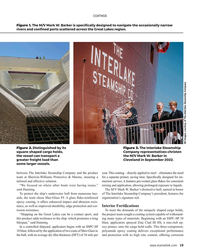 )
January 2024 - Maritime Reporter and Engineering News page: 19
)
January 2024 - Maritime Reporter and Engineering News page: 19vessels. between The Interlake Steamship Company and the product coat. This coating – directly applied to steel – eliminates the need team at Sherwin-Williams Protective & Marine, ensuring a for a separate primer, saving time. Speci? cally designed for im- tailored and effective solution. mersion service
-
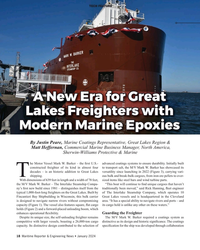 )
January 2024 - Maritime Reporter and Engineering News page: 18
)
January 2024 - Maritime Reporter and Engineering News page: 18Epoxies By Justin Peare, Marine Coatings Representative, Great Lakes Region & Matt Heffernan, Commercial Marine Business Manager, North America, Sherwin-Williams Protective & Marine he Motor Vessel Mark W. Barker – the ? rst U.S.- advanced coatings systems to ensure durability. Initially built constructed
-
 )
January 2024 - Maritime Reporter and Engineering News page: 4
)
January 2024 - Maritime Reporter and Engineering News page: 4www.marinelink.com are solely those of the author. of North America with Sherwin- t: (212) 477-6700 f: (212) 254-6271 Reference to any speci? c com- Williams Protective & Marine. He Peare mercial companies, products, is a NACE III-Certi? ed industrial Justin Peare is the Marine Coat- process, or service
-
 )
November 2023 - Marine Technology Reporter page: 14
)
November 2023 - Marine Technology Reporter page: 14and adaptability of malicious cy- Submarine League, then NAVSEA commander Vice Adm. ber actors, resilience - the ability to quickly detect, mitigate, William Hilarides addressed the serious risk posed by off- and recover from cyberattacks - is key, as is leveraging profes- board networks to submarines,
-
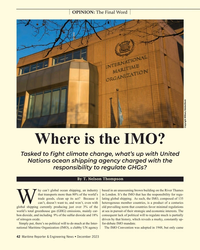 )
December 2023 - Maritime Reporter and Engineering News page: 42
)
December 2023 - Maritime Reporter and Engineering News page: 42OPINION: The Final Word Copyright William/AdobeStock Where is the IMO? Tasked to ? ght climate change, what’s up with United Nations ocean shipping agency charged with the responsibility to regulate GHGs? By T. Nelson Thompson hy can’t global ocean shipping, an industry based in an unassuming brown
-
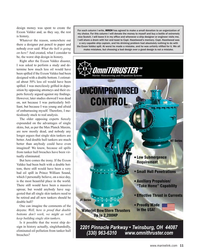 )
December 2023 - Maritime Reporter and Engineering News page: 11
)
December 2023 - Maritime Reporter and Engineering News page: 11. But here comes the irony. If the Exxon Valdez had been built with a double bot- tom, there still would have been a very bad oil spill in Prince William Sound, which I personally believe, on a nice day, is the most beautiful place in the world. There still would have been a massive uproar, but
-
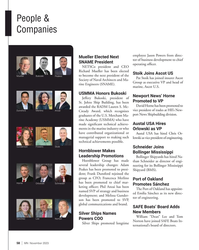 )
November 2023 - Marine News page: 58
)
November 2023 - Marine News page: 58Gunder- son has been promoted to SVP, tor of engineering. global communications and brand. SAFE Boats’ Board Adds New Members Silver Ships Names William “Dean” Lee and Tom Sánchez Lee Norton Powers COO Silver Ships promoted longtime Norton have joined SAFE Boats In- ternational’s board of directors
-
 )
November 2023 - Marine News page: 18
)
November 2023 - Marine News page: 18of eligible U.S.-fag vessels priations Act, 2023, added more than $212 million to the to defer federal taxes on income from vessel operations and © William A. Morgan / Adobe Stock 18 | MN November 202
-
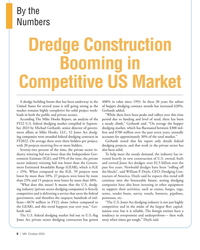 )
November 2023 - Marine News page: 8
)
November 2023 - Marine News page: 8(GEAR), which is IGE past ? ve years. Newbuild dredges have been “rolling off + 25%. When compared to the IGE, 59 projects were the blocks”, said William P. Doyle, CEO, Dredging Con- lower by more than 10%, 27 projects were lower by more tractors of America. Doyle said he expects this trend will than
-
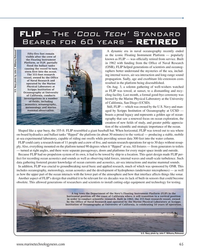 )
September 2023 - Marine Technology Reporter page: 65
)
September 2023 - Marine Technology Reporter page: 653, a solemn gathering of well-wishers watched Scripps Institution of as FLIP was towed, at sunset, to a dismantling and recy- U.S. Navy photo by John F. Williams/Released Oceanography at University cling facility. Last month, a formal good-bye ceremony was of California, conducts investigations in a number
-
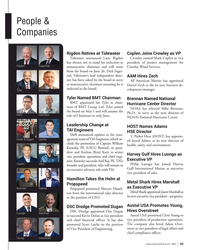 )
June 2023 - Marine News page: 43
)
June 2023 - Marine News page: 43(HOST) has appoint- agement team of TAI Engineers, which in- Dolan & Dugan Laiche ed Jarred Adams as its new director of clude the promotion of Captain William health, safety and environment. Krewsky, PE (USCG Retired), to presi- dent and Krishna (Kris) Karri to senior Harvey Gulf Hires Luongo as vice
-
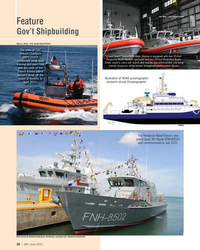 )
June 2023 - Marine News page: 30
)
June 2023 - Marine News page: 30Ian Gray / U.S. Coast Guard Feature Gov’t Shipbuilding Ryan L. Noel / U.S. Coast Guard Photo The crew of CGC William Chadwick Coast Guard Station Ketchikan, Alaska is equipped with two 45-foot (WPC-1150) Response Boats-Medium (pictured and two 29-foot Response Boats- conducted small boat Small, used to
-
 )
August 2023 - Maritime Reporter and Engineering News page: 53
)
August 2023 - Maritime Reporter and Engineering News page: 53, a provider of immersive wildlife experiences on the USCG Cut er Kona Coast. Artemis is a 42 x 16-ft. vessel, purpose-built to enhance their mis- William Tate Fix sion of cultivating connections between communities and marine wildlife. Earlier this year, Bayonne Drydock Artemis is equipped with Twin
-
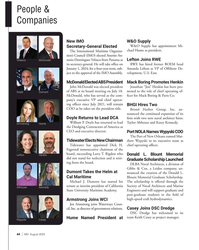 )
August 2023 - Marine News page: 44
)
August 2023 - Marine News page: 44title. Bristol Harbor Group, Inc. an- nounced the continued expansion of its Doyle Returns to Lead DCA ? rm with two new naval architect hires: William P. Doyle has returned to lead Taylor Althouse and Kasey Kennedy. Armstrong Hume the Dredging Contractors of America as CEO and executive director
-
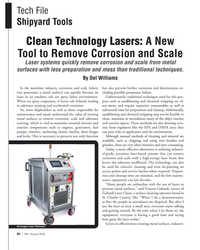 )
August 2023 - Marine News page: 40
)
August 2023 - Marine News page: 40and Scale Laser systems quickly remove corrosion and scale from metal surfaces with less preparation and mess than traditional techniques. By Del Williams In the maritime industry, corrosion and scale (where but also prevent further corrosion and deterioration in- rust penetrates a metal surface) can
-
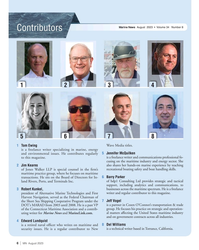 )
August 2023 - Marine News page: 6
)
August 2023 - Marine News page: 6maritime industry and on government contracts across all industries. 4 Edward Lundquist is a retired naval of? cer who writes on maritime and 8 Del Williams security issues. He is a regular contributor to New is a technical writer based in Torrance, California. 6 | MN August 202
-
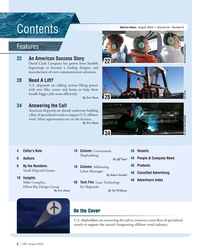 )
August 2023 - Marine News page: 2
)
August 2023 - Marine News page: 2Advertisers Index Mike Complita, 40 Tech File: Laser Technology Elliott Bay Design Group for Shipyards By Eric Haun By Del Williams On the Cover U.S. shipbuilders are answering the call to construct a new ? eet of specialized vessels to support the nation’s burgeoning offshore
-
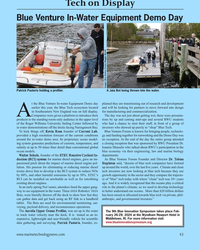 )
July 2023 - Marine Technology Reporter page: 43
)
July 2023 - Marine Technology Reporter page: 43were presenta- products to the standing-room-only audience in the upper level tions by up and coming start-ups and several RWU students of the Roger Williams University Sailing Center followed by who had a chance to strut their stuff, in front of a group of in water demonstrations off the docks facing
-
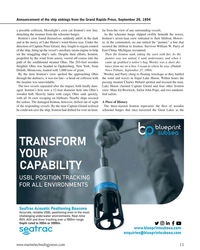 )
March 2023 - Marine Technology Reporter page: 13
)
March 2023 - Marine Technology Reporter page: 13, no one untied the “painter,” a line that direction of Captain Peter Girard, they fought to regain control secured the lifeboat to Ironton. Survivor William W. Parry of of the ship, ? ring up the vessel’s auxiliary steam engine to help East China, Michigan, recounted: set the struggling ship’s sails
-
 )
January 2023 - Marine Technology Reporter page: 41
)
January 2023 - Marine Technology Reporter page: 41of similar performance. and weighing 200g, its volume is 54% Sonar. lower and weighs 42% less than its pre- • 0.01° roll and pitch On its website, James Williams, Di- • 0.1° secant latitude decessor the DMU30. For those looking rector USS is quoted as saying “Nav- for a single axis gyro, the company’s
-
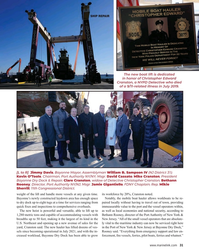 )
January 2023 - Maritime Reporter and Engineering News page: 31
)
January 2023 - Maritime Reporter and Engineering News page: 31of Christopher Edward Cranston, a NYPD Detective who died of a 9/11-related illness in July 2019. [L to R] Jimmy Davis, Bayonne Mayor; Assemblyman William B. Sampson IV (NJ District 31); Kevin O’Toole, Chairman, Port Authority NY/NY; Msgr. David Cassato; Mike Cranston, President Bayonne Dry Dock &
-
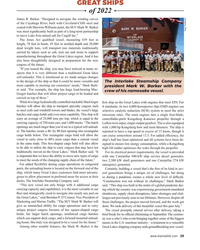 )
December 2022 - Maritime Reporter and Engineering News page: 29
)
December 2022 - Maritime Reporter and Engineering News page: 29SHIPS of 2022 James R. Barker. “Designed to navigate the winding curves of the Cuyahoga River, built with Cleveland-Cliffs steel and coated with Sherwin-Williams paint, the M/V Mark W. Barker Greg Trauthwein was most signi? cantly built as part of a long-term partnership to move Lake Erie-mined salt for
-
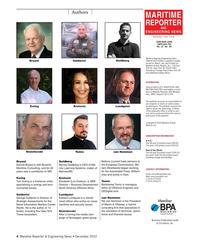 )
December 2022 - Maritime Reporter and Engineering News page: 4
)
December 2022 - Maritime Reporter and Engineering News page: 4rine Learning Systems, maker of liam Stoichevski began working CONTACT INFORMATION: years was a contributor to MR. MarineLMS. for the Associated Press. William Email: [email protected] lives and works in Oslo. Web: www.marinelink.com Ewing Kretovic t: (212) 477-6700 f: (212) 254-6271 Tom Ewing
-
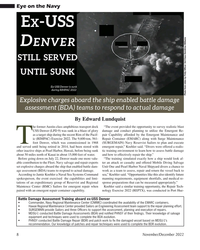 )
November 2022 - Marine Technology Reporter page: 8
)
November 2022 - Marine Technology Reporter page: 8on the Navy E -USS X D ENVER STILL SERVED UNTIL SUNK Ex-USS Denver is sunk during RIMPAC 2022 Photo from video by Petty Of? cer 3rd Class Demitrius Williams Explosive charges aboard the ship enabled battle damage assessment (BDA) teams to respond to actual damage By Edward Lundquist he former Austin-class
